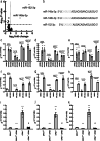Inhibition of the mitochondrial protein Opa1 curtails breast cancer growth
- PMID: 35279198
- PMCID: PMC8917763
- DOI: 10.1186/s13046-022-02304-6
Inhibition of the mitochondrial protein Opa1 curtails breast cancer growth
Abstract
Background: Mitochondrial fusion and fission proteins have been nominated as druggable targets in cancer. Whether their inhibition is efficacious in triple negative breast cancer (TNBC) that almost invariably develops chemoresistance is unknown.
Methods: We used a combination of bioinformatics analyses of cancer genomic databases, genetic and pharmacological Optic Atrophy 1 (OPA1) inhibition, mitochondrial function and morphology measurements, micro-RNA (miRNA) profiling and formal epistatic analyses to address the role of OPA1 in TNBC proliferation, migration, and invasion in vitro and in vivo.
Results: We identified a signature of OPA1 upregulation in breast cancer that correlates with worse prognosis. Accordingly, OPA1 inhibition could reduce breast cancer cells proliferation, migration, and invasion in vitro and in vivo. Mechanistically, while OPA1 silencing did not reduce mitochondrial respiration, it increased levels of miRNAs of the 148/152 family known to inhibit tumor growth and invasiveness. Indeed, these miRNAs were epistatic to OPA1 in the regulation of TNBC cells growth and invasiveness.
Conclusions: Our data show that targeted inhibition of the mitochondrial fusion protein OPA1 curtails TNBC growth and nominate OPA1 as a druggable target in TNBC.
© 2022. The Author(s).
Conflict of interest statement
LS is an inventor in the PCT/EP2019/068846 on MYLS22 as an anticancer drug. All other authors declare no competing interest.
Figures







References
MeSH terms
Substances
Grants and funding
LinkOut - more resources
Full Text Sources
Research Materials

